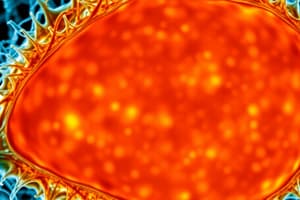Podcast
Questions and Answers
What is the primary function of a microscope?
What is the primary function of a microscope?
- To observe objects that are too small to be seen with the naked eye (correct)
- To illuminate objects using lasers
- To enhance the color of objects
- To measure the size of large objects
Which type of microscope is ideal for viewing live cells?
Which type of microscope is ideal for viewing live cells?
- Light microscope (correct)
- Phase contrast microscope
- Transmission electron microscope
- Scanning electron microscope
What key feature distinguishes magnification from resolution in microscopy?
What key feature distinguishes magnification from resolution in microscopy?
- Magnification and resolution are the same
- Magnification determines color clarity, while resolution determines viewable size
- Magnification allows viewing of live specimens, while resolution does not
- Magnification enlarges the appearance of objects, while resolution improves clarity (correct)
Which of these statements is accurate for electron microscopes?
Which of these statements is accurate for electron microscopes?
What is a limitation of using an electron microscope?
What is a limitation of using an electron microscope?
How is the magnification calculated?
How is the magnification calculated?
Which of the following is NOT a characteristic of light microscopes?
Which of the following is NOT a characteristic of light microscopes?
In microscopy, why is resolution considered more important than magnification?
In microscopy, why is resolution considered more important than magnification?
Flashcards are hidden until you start studying
Study Notes
What is a Microscope?
- A microscope is an important scientific instrument designed for viewing objects that are too small to be seen with the naked eye. This capability allows researchers and students to explore and study the minutiae of biological specimens, materials, and other tiny entities.
- There are two main types of microscopes utilized in various fields of science and education: light microscopes and electron microscopes. Each type has its unique principles of operation and application capabilities, catering to different research needs and specimen types.
Light Microscopes
- Light microscopes operate by utilizing visible light to produce magnified images of the specimen being observed. They can enhance the visual perception of small features, making them invaluable tools in both educational and laboratory settings.
- They are particularly ideal for viewing live specimens, which offers a dynamic insight into biological processes such as cell division and movement. This capability extends to observing cells and tissues, as well as larger cellular structures such as nuclei and chloroplasts, which are essential for understanding organismal biology.
- These microscopes are generally more affordable and user-friendly compared to their electron counterparts, making them accessible for schools and small laboratories. Their straightforward design encourages hands-on learning and experimentation without the need for extensive training.
- However, light microscopes have limitations given their lower magnification and resolution compared to electron microscopes. Consequently, they often cannot reveal smaller organelles, such as ribosomes or membrane structures, which are crucial for detailed cellular biology studies.
Electron Microscopes
- Electron microscopes utilize a focused beam of electrons instead of visible light as their light source. This method of imaging allows for significantly higher resolution and magnification capabilities, revealing incredibly detailed structures at the cellular and sub-cellular levels.
- These microscopes are capable of providing extraordinary detail that aids researchers in understanding complex structures, such as the intricacies of cell membranes and protein complexes, making them essential tools in areas such as molecular biology and materials science.
- Despite their advanced capabilities, electron microscopes have certain restrictions; they cannot be used to view live specimens due to the vacuum environment required for electron imaging. This component greatly limits the type of biological studies that can be conducted. Furthermore, electron microscopes are expensive and require specialized knowledge and training for effective use, which may not be feasible for all laboratories.
Key Words - Magnification & Resolution
- Magnification refers to the enlargement of an object's appearance through the microscope, making it appear larger than its actual size. It is an essential factor that allows scientists to investigate structures that would otherwise go unnoticed.
- Resolution involves the microscope's ability to distinguish between two closely spaced objects. High resolution is key to achieving clearer details, allowing for the identification of fine structures within specimens.
- A microscope with higher resolution enables researchers to perform detailed analysis, providing essential insights into the organization and function of cells and materials being studied.
Comparing Light and Electron Microscopes
- Notably, electron microscopes are considerably more expensive than their light microscope counterparts, making them less accessible for some institutions and studies.
- In addition to differences in cost, the images produced by these two types of microscopes vary significantly; light microscopes are capable of producing colored images, which can enhance the comprehension of specimen features, while electron microscopes produce only black and white images, requiring additional steps for color representation in their analyses.
- Furthermore, electron microscopes require that specimens be dead prior to observation, whereas light microscopes facilitate the viewing of both living and dead specimens. This feature allows for a wider range of biological observations, from live cell interactions to the structural analysis of fixed cells.
- Another critical difference is that electron microscopes possess superior resolution capabilities compared to light microscopes. This advantage allows scientists to investigate finer details with electron microscopy, which is crucial for advancing knowledge in various scientific fields.
- In terms of magnification prowess, electron microscopes again hold an advantage over light microscopes, thereby allowing researchers to examine smaller structures and gain deeper insights into cellular function and material properties.
- Both types of microscopes incorporate lenses as a fundamental component of their design; however, electron microscopes utilize electromagnetic lenses for focusing the electron beam, whereas light microscopes employ glass lenses to direct light, and this distinction contributes to their differences in functionality.
Light Microscope Parts
- Base: The bottom component of the microscope that provides essential stability and support, ensuring the instrument remains steady during observation and focusing.
- Stage: The horizontal platform where the specimen slide is placed, enabling precise positioning of the sample for optimal viewing.
- Stage clips: Small metal clips used to securely hold the slide in place on the stage, preventing movement that could disrupt the observation process.
- Diaphragm: A mechanical component that regulates the amount of light passing through the specimen. By adjusting the diaphragm, users can improve contrast and clarity of the image being viewed.
- Light source: A critical element that provides illumination for viewing the specimen, often consisting of a built-in bulb or a mirror that directs ambient light onto the sample.
- Coarse focus knob: A larger knob that adjusts the height of the stage significantly, used for initial focusing of the specimen at low magnification.
- Fine focus knob: A smaller knob that allows for fine adjustments in focus, essential for attaining clarity at higher magnifications, enabling users to observe more intricate details within the sample.
- Eyepiece lens (10x): The lens through which the user looks to observe the magnified image of the specimen. This lens is often marked with its magnification power, usually 10x, which contributes to the overall magnification achieved.
- Objective lens: These lenses are positioned on a rotating turret typically located above the stage. Each lens has different magnification levels marked on them, allowing users to switch quickly between magnifications to observe specimens at varying levels of detail.
Calculating Magnification
- To understand how to calculate magnification, it is important to know that it is determined by multiplying the magnification of the eyepiece lens by that of the objective lens. This process enables users to quantify the total enlargement achieved through the microscope.
- For example, if the eyepiece lens has a magnification power of 10x and the objective lens being utilized has a magnification power of 40x, the total magnification observed through the microscope would be calculated as 10 x 40 = 400x. This total magnification illustrates the significant enlargement of the specimen, facilitating closer examination of its properties and structures.
Studying That Suits You
Use AI to generate personalized quizzes and flashcards to suit your learning preferences.




